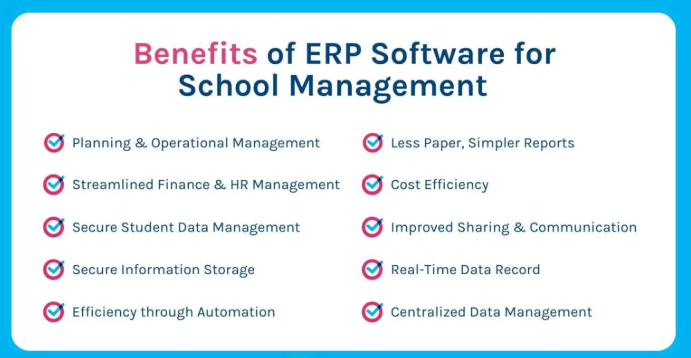Enterprise Resource Planning in School Market Share Growing Rapidly with Recent Trends and Outlook 2035

Enterprise Resource Planning in School Market
Enterprise Resource Planning (ERP) systems have become integral to the efficient management of educational institutions worldwide. By integrating various administrative and academic processes, ERP solutions enhance operational efficiency, data accuracy, and decision-making capabilities. This article delves into the ERP market within the educational sector, focusing on market overview, key segments, recent industry developments, leading companies, market drivers, and regional insights.
Market Overview
As per MRFR analysis, the Enterprise Resource Planning in School Market Size was estimated at 2.79 (USD Billion) in 2023. The Enterprise Resource Planning in the School Market Industry is expected to grow from 2.93(USD Billion) in 2024 to 5.0 (USD Billion) by 2035.
Request To Free Sample of This Strategic Report - https://www.marketresearchfuture.com/sample_request/42342
Key Market Segments
The Education ERP market is segmented based on components, deployment models, applications, and end-users:
-
Component:
- Software: Comprehensive ERP platforms offering modules for various administrative and academic functions.
- Services: Implementation, training, support, and maintenance services to ensure optimal utilization of ERP systems.
-
Deployment Model:
- On-Premise: ERP systems hosted on the institution's local servers, providing greater control over data and customization.
- Cloud-Based: ERP solutions hosted on remote servers, offering scalability, remote access, and reduced IT infrastructure costs.
-
Application:
- Administration Management: Streamlining processes such as admissions, attendance, and scheduling.
- Academic Management: Managing curricula, assessments, and grading systems.
- Finance and Accounting Management: Overseeing budgeting, payroll, and financial reporting.
- Human Resource Management: Handling staff recruitment, performance evaluations, and payroll.
- Student Management: Maintaining student records, tracking progress, and facilitating communication.
-
End-User:
- K-12 Institutions: Primary and secondary educational institutions seeking to manage operations efficiently.
- Higher Education Institutions: Universities and colleges aiming to integrate complex administrative and academic processes.
Industry Latest News
The Education ERP market has witnessed significant developments, including mergers and acquisitions, partnerships, and technological advancements. Leading companies are focusing on enhancing their product offerings through artificial intelligence (AI) and machine learning (ML) to provide predictive analytics and personalized learning experiences. Additionally, there is a growing emphasis on data security and compliance with regulations such as the General Data Protection Regulation (GDPR) to protect student and institutional data.
Key Companies
Several prominent players dominate the Education ERP market, offering comprehensive solutions tailored to the needs of educational institutions:
- SAP SE: Provides ERP solutions that integrate administrative and academic processes, enhancing operational efficiency.
- Oracle Corporation: Offers cloud-based ERP systems with modules for student management, finance, and human resources.
- Microsoft Corporation: Delivers ERP solutions focusing on collaboration, data analytics, and process automation.
- Infor Inc.: Specializes in ERP systems that cater to the unique requirements of educational institutions, including facilities management and procurement.
- Ellucian: Focuses exclusively on higher education, providing ERP solutions that support student success and institutional growth.
These companies are investing in research and development to introduce innovative features and maintain a competitive edge in the market.
Market Drivers
Several factors are propelling the growth of the Education ERP market:
-
Demand for Automated Processes: Educational institutions are increasingly seeking to automate administrative tasks to reduce manual errors, save time, and improve efficiency.
-
Cloud Adoption: The shift towards cloud-based solutions offers institutions flexibility, scalability, and cost savings, driving the adoption of cloud-based ERP systems.
-
Data-Driven Decision Making: ERP systems provide real-time data analytics, enabling institutions to make informed decisions regarding resource allocation, student performance, and strategic planning.
-
Regulatory Compliance: ERP solutions assist institutions in adhering to regulatory requirements by maintaining accurate records and generating necessary reports.
-
Enhanced Stakeholder Communication: ERP systems facilitate better communication among students, faculty, administrators, and parents, fostering a collaborative educational environment.
Browse In-depth Market Research Report - https://www.marketresearchfuture.com/reports/enterprise-resource-planning-in-school-market-42342
Regional Insights
The adoption of Education ERP systems varies across regions:
-
North America: Holds the largest market share due to the early adoption of technology, substantial investments in educational infrastructure, and the presence of major ERP vendors.
-
Europe: Experiences steady growth driven by government initiatives promoting digitalization in education and a focus on data security.
-
Asia-Pacific: Anticipated to witness the fastest growth rate, attributed to the expanding educational sector, increasing enrollment rates, and rising awareness of the benefits of ERP systems.
-
Latin America and Middle East & Africa: Show emerging potential with gradual adoption as institutions in these regions modernize their administrative processes.
Challenges and Opportunities
Despite the positive outlook, the Education ERP market faces challenges such as:
-
High Implementation Costs: The initial investment for ERP systems can be substantial, deterring smaller institutions with limited budgets.
-
Resistance to Change: Stakeholders accustomed to traditional methods may resist transitioning to automated systems.
-
Data Privacy Concerns: Ensuring the security of sensitive student and institutional data remains a critical concern.
However, these challenges present opportunities for vendors to offer scalable pricing models, provide comprehensive training programs, and develop robust security features to address data privacy issues.
- Enterprise_Resource_Planning_in_School_Market
- Enterprise_Resource_Planning_in_School_Market_Share
- Enterprise_Resource_Planning_in_School_Market_Size
- Enterprise_Resource_Planning_in_School_Market_Growth
- Enterprise_Resource_Planning_in_School_Market_Segments
- Enterprise_Resource_Planning_in_School_Market_SWOT_Analysis
- Questions and Answers
- Opinion
- Motivational and Inspiring Story
- Technology
- True & Inspiring Quotes
- Live and Let live
- Focus
- Geopolitics
- Military-Arms/Equipment
- Güvenlik
- Economy/Economic
- Art
- Causes
- Crafts
- Dance
- Drinks
- Film/Movie
- Fitness
- Food
- Oyunlar
- Gardening
- Health
- Home
- Literature
- Music
- Networking
- Other
- Party
- Religion
- Shopping
- Sports
- Theater
- Health and Wellness
- News
- Culture

